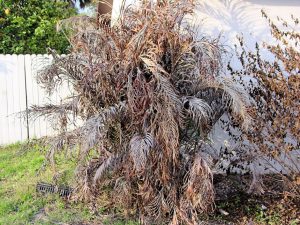
With our recent freeze hopefully behind us, I wanted to focus more on the damage suffered by area palms and how to deal with these landscape patients. Beyond our hardy palms such as Sabal, Sylvester, Canary Island Date, Saw Palmettos, etc., our more tender/marginal palms took a beating! While there are no guarantees with living things, it is very likely that most of our damaged palms will eventually recover.
Freeze damage to palms is going to depend on their location in the County, how long the freezing event lasted, how cold-hardened the palms were, and how well their nutritional condition was. Tender palms near the coast may have experienced little to no damage, while those east of 41 and especially east of 75 were damaged the most. The freezing temperatures were likely for only a period of a few hours, but this is often enough to bronze the fronds and make the palm not look very ornamental. The more gradual our weather changes are over a period of weeks from warm to cold, the better apt the palms are to tolerate the cold snap. Nutritionally, a properly fertilized tropical palm will be better able to tolerate cold temperatures. If you are not presently providing fertilizer, we would recommend a slow-release granular fertilizer 8-2-12-4 (or 8-0-12-4) applied in November, February and *May as per label directions. In August use a 0-0-16-6, again as per label directions. Freeze-damaged palms are stressed at this point, so perhaps wait until the *May feeding to begin this program.
Most of our palms suffering from freeze-damage have fronds with a reddish/bronze coloration. Do not prune these fronds out! Even damaged fronds can make and store food. Also, damaged fronds do provide some insulation to the bud. The bud is the key point to the survival of the palm as it is the growing point for all future fronds. The bud is fairly well protected down in the center of the frond bases/crown shaft. If it was cold enough for the spearleaf to be damaged, the use of copper fungicide (not a copper nutrient spray or drench) may help reduce any further damage to the bud by fungi or bacteria. Do not use water-soluble compounds like copper sulfate unless they have been neutralized according to the label. Water-soluble copper compounds will damage palm foliage. From a quick glance across the landscape, I do not think that copper fungicide would be needed as a result of this freezing event.
Palm trunk damage from freezes can also occur. It may take months to manifest itself, so just monitor for now.
The bottom-line is that on occasion we have freezes that damage palms in our area. Depending on the type and location of the palm, a variety of damage can occur. Most of this damage can be managed with the help of patience for now, proper fertilization in the future, and water as needed during the dry season to help support recovery. Some landscape palms do not look very ornamental right now, but they should improve with time and regrowth. For more information on all types of palm issues, or to ask a question, please visit https://www.facebook.com/CharlotteMGLifeline/ . Ralph E. Mitchell is the Director/Horticulture Agent for the UF/IFAS Charlotte County Extension Service. He can be reached at 941-764-4344 or ralph.mitchell@charlottecountyfl.gov.
Resources:
Broschat, T. K. (2021) Cold Damage on Palms. The University of Florida Extension Service, IFAS.
Broschat, T. K. (2021) Fertilization of Field-grown and Landscape Palms in Florida. The University of Florida Extension Service, IFAS.
Broschat, T. K. (2021) Not All Landscape Palm Fertilizers Are Created Equal. The University of Florida Extension Service, IFAS.
 2
2
